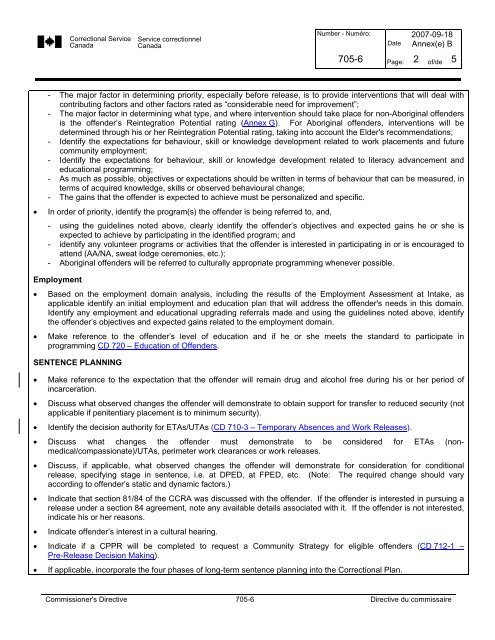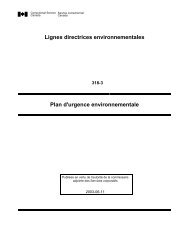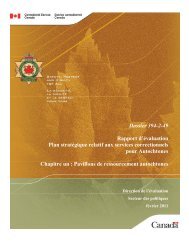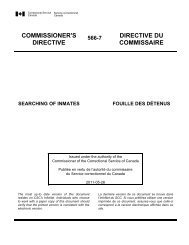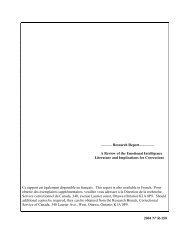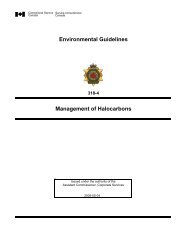CD 705-6 - Correctional Planning and Criminal Profile - Service ...
CD 705-6 - Correctional Planning and Criminal Profile - Service ...
CD 705-6 - Correctional Planning and Criminal Profile - Service ...
Create successful ePaper yourself
Turn your PDF publications into a flip-book with our unique Google optimized e-Paper software.
<strong>Correctional</strong> <strong>Service</strong> <strong>Service</strong> correctionnel<br />
Canada Canada<br />
Number - Numéro: 2007-09-18<br />
Date Annex(e) B<br />
<strong>705</strong>-6 Page: 2 of/de 5<br />
- The major factor in determining priority, especially before release, is to provide interventions that will deal with<br />
contributing factors <strong>and</strong> other factors rated as “considerable need for improvement”;<br />
- The major factor in determining what type, <strong>and</strong> where intervention should take place for non-Aboriginal offenders<br />
is the offender’s Reintegration Potential rating (Annex G). For Aboriginal offenders, interventions will be<br />
determined through his or her Reintegration Potential rating, taking into account the Elder's recommendations;<br />
- Identify the expectations for behaviour, skill or knowledge development related to work placements <strong>and</strong> future<br />
community employment;<br />
- Identify the expectations for behaviour, skill or knowledge development related to literacy advancement <strong>and</strong><br />
educational programming;<br />
- As much as possible, objectives or expectations should be written in terms of behaviour that can be measured, in<br />
terms of acquired knowledge, skills or observed behavioural change;<br />
- The gains that the offender is expected to achieve must be personalized <strong>and</strong> specific.<br />
• In order of priority, identify the program(s) the offender is being referred to, <strong>and</strong>,<br />
- using the guidelines noted above, clearly identify the offender’s objectives <strong>and</strong> expected gains he or she is<br />
expected to achieve by participating in the identified program; <strong>and</strong><br />
- identify any volunteer programs or activities that the offender is interested in participating in or is encouraged to<br />
attend (AA/NA, sweat lodge ceremonies, etc.);<br />
- Aboriginal offenders will be referred to culturally appropriate programming whenever possible.<br />
Employment<br />
• Based on the employment domain analysis, including the results of the Employment Assessment at Intake, as<br />
applicable identify an initial employment <strong>and</strong> education plan that will address the offender's needs in this domain.<br />
Identify any employment <strong>and</strong> educational upgrading referrals made <strong>and</strong> using the guidelines noted above, identify<br />
the offender’s objectives <strong>and</strong> expected gains related to the employment domain.<br />
• Make reference to the offender’s level of education <strong>and</strong> if he or she meets the st<strong>and</strong>ard to participate in<br />
programming <strong>CD</strong> 720 – Education of Offenders.<br />
SENTENCE PLANNING<br />
• Make reference to the expectation that the offender will remain drug <strong>and</strong> alcohol free during his or her period of<br />
incarceration.<br />
• Discuss what observed changes the offender will demonstrate to obtain support for transfer to reduced security (not<br />
applicable if penitentiary placement is to minimum security).<br />
• Identify the decision authority for ETAs/UTAs (<strong>CD</strong> 710-3 – Temporary Absences <strong>and</strong> Work Releases).<br />
• Discuss what changes the offender must demonstrate to be considered for ETAs (nonmedical/compassionate)/UTAs,<br />
perimeter work clearances or work releases.<br />
• Discuss, if applicable, what observed changes the offender will demonstrate for consideration for conditional<br />
release, specifying stage in sentence, i.e. at DPED, at FPED, etc. (Note: The required change should vary<br />
according to offender’s static <strong>and</strong> dynamic factors.)<br />
• Indicate that section 81/84 of the CCRA was discussed with the offender. If the offender is interested in pursuing a<br />
release under a section 84 agreement, note any available details associated with it. If the offender is not interested,<br />
indicate his or her reasons.<br />
• Indicate offender’s interest in a cultural hearing.<br />
• Indicate if a CPPR will be completed to request a Community Strategy for eligible offenders (<strong>CD</strong> 712-1 –<br />
Pre-Release Decision Making).<br />
• If applicable, incorporate the four phases of long-term sentence planning into the <strong>Correctional</strong> Plan.<br />
Commissioner's Directive <strong>705</strong>-6 Directive du commissaire


